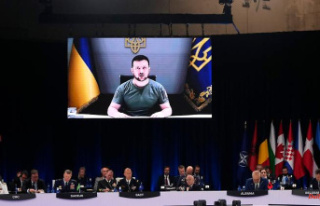Mariupol, Kherson, Sieverodonetsk - these cities are examples of the devastation that Russia is wreaking on Ukraine. The war damage caused already amounts to several hundred billion dollars. Tendency to increase the longer the war lasts.
Destroyed factories, broken streets and attacked city blocks. The damage in Ukraine is increasing day by day. Russia shoots and bombs entire regions and has leveled some cities to the ground. Conquest at all costs. This is how the Russian soldiers act in their neighboring country. Kremlin boss Vladimir Putin wants it that way. He doesn't care how badly Ukraine is destroyed, military expert Carlo Masala from the Bundeswehr University explained in the Stern podcast "Ukraine - the situation". "From a purely objective point of view, you don't want to have such a country occupied. But since President Putin is not only, but also on a historic mission, namely to bring parts of Ukraine back to Russia, it doesn't really matter to him whether he takes over an entire desert or not."
Bernd Ziesemer also deals with the Russian campaign of destruction every day. The journalist and Russia expert is a columnist for the business magazine "Capital" and was editor-in-chief of the "Handelsblatt" for many years. In the podcast "Zero Hour", the business podcast by Capital and ntv, he says that Russia is "acting like a steamroller to conquer Ukrainian territories". The result was "complete destruction". Russian warfare is "designed to destroy virtually all infrastructure and entire cities."
"That's why this war is so expensive. This type of warfare, this destruction of factories, of infrastructure, in a developed country in the middle of Europe, has devastating economic consequences," analyzes Ziesemer, who notes that the war is over after just 100 days the "economically most expensive war since the Second World War".
The destruction in Donbass is particularly severe. Especially since the Russian army has largely withdrawn from other parts of the country and is concentrating its attacks on eastern Ukraine. "An area three times the size of North Rhine-Westphalia. And its structure is a bit similar to North Rhine-Westphalia. One speaks of the Donbass as the Ruhr area of Ukraine," notes Ziesemer. "There are a lot of factories there, steel industry, heavy industry, mechanical engineering."
A large part of the "Ruhr area of Ukraine" has now been destroyed. The extent of the damage throughout Ukraine is meticulously documented at the Kyiv School of Economics. For the entire country, the researchers estimated the total amount of direct damage after 100 days of war at 103.9 billion dollars. The largest proportion - about 40 percent - is made up of destroyed residential buildings, followed by broken roads with just over 30 percent. In addition, more than 250 companies, 650 hospitals, more than 1,100 schools, almost 700 kindergartens, 200 warehouses, 20 shopping centers and 28 oil depots were "damaged, destroyed or confiscated".
"In addition, of course, there are the economic follow-up costs, so that the total comes to a total of probably 500 to 600 billion euros on the Ukrainian side alone," estimates Ziesemer. According to Werner Hoyer, head of the European Investment Bank, Ukraine needs up to one trillion euros in external aid payments to one day repair the damage caused by the war. According to Hoyer, Europe will have to pay the lion's share. For comparison: the largest aid package that the EU put together during Corona was 750 billion euros.
Reconstruction is becoming a "generational task," Olaf Scholz recently emphasized in the Bundestag. "The extent of the destruction is enormous. Some things remind me, not just me, of the pictures of the destroyed German cities after the Second World War," said the Chancellor. "And like war-ravaged Europe back then, Ukraine needs a Marshall Plan for reconstruction."
In the first few years after the end of the World War, the economy was devastated. The US wanted to do something about it. Secretary of State George Marshall announced the European Recovery Program, the Marshall Plan, in 1947. Finally, from 1948 to 1952, about $13 billion was invested in rebuilding Europe. That equates to more than $140 billion today. The USA wanted to ensure that a strong Europe was positioned against the Eastern bloc. The Marshall Plan was an antidote to the spread of Communism.
"If this development hadn't taken place after World War II, we would be living in a different country. Without the United States and the transatlantic alliance, we wouldn't be where we are today," says historian Jessica Gienow-Hecht from Freie Universität Berlin explained in an interview with the Konrad Adenauer Foundation.
The Marshall Plan has more than exceeded its goals, says the professor. Money and consumer goods flowed to Europe, the domestic market was set in motion again, and economies were liberalized. "When the Chancellor or the Ukrainian President speak of a Marshall Plan for Ukraine, they mean a generous humanitarian program that will help Ukraine get back on its feet economically after the war. But that's not the Marshall Plan," emphasizes Gienow-Hecht.
For a real Marshall Plan, the US and Europe would first have to agree that one day after the end of the war they want to invest massive amounts of money in Ukraine in order to rebuild the state and strengthen democracy, according to the historian. Secondly, a clear goal is needed as to what exactly one wants to achieve in Ukraine. Thirdly, an institution is needed to organize the financial aid. "Internationally comprehensive, maybe linked to the World Bank or a similar institution that looks at the applications from Ukraine and decides on the award. The next step would then have to be a decision on which criteria would be linked to this award," suggests Gienow-Hecht .
An end to the war in Ukraine is not yet in sight. However, there is no harm in thinking about the reconstruction of the country now. Volodymyr Zelenskyy also frequently addresses the topic in his video messages. "Every house, every street, every city will be rebuilt," announced the Ukrainian president. Of course, he also relies on help from the West.












